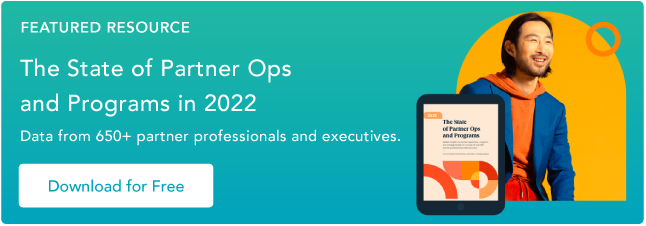Believe it or not, your company's sales efforts don't have to be confined exclusively to your sales organization. In many cases, there's a base of potential collaborators who might be interested in folding your product or service into their sales operations as well.

The process of coordinating and carrying out that kind of cooperation is known as partner enablement — a way to tap and train businesses beyond yours to sell your product or service on their own.
Partner enablement can be tricky to navigate, and creating a successful program for your organization requires you to cover certain bases and take specific strides. Here, we'll give you some more perspective on the concept of partner enablement and go over the partner enablement process.
What is partner enablement?
Partner enablement is the practice of supporting your partners with the proper training, materials, and information to execute your sales process and sell your product or service. The process involves both technical and sales-related elements.
The word "partner" in the phrase "partner enablement" is a fairly broad, catch-all term that refers to a series of different outlets that might sell your product or service.
In this context, partners — also known as "channel partners" — can be resellers, managed service providers (MSPs), distributors, or any other entity that you trust to understand your solution and execute your sales process.
Partner enablement can be a complicated game. Different partners will have varying degrees of sales acumen and technical knowledge. Some might be excellent salespeople who struggle with the nuts and bolts of your product or service. Others might be able to fully grasp how your solution works, right off the bat, but have trouble engaging with prospects.
That variability in knowledge and skill can muddle your partner enablement strategy. You might have to provide different kinds of resources, information, and attention to individual partners.
Still, there's a general process you can use as a reference point when coordinating and executing your partner enablement program.
Partner Enablement Process
- Onboard partners.
- Determine mutual goals and targets.
- Conduct extensive partner training.
- Keep partners posted on updates to your product or service.
1. Onboard partners.
In this context, onboarding is the process of getting partners acquainted with your business and the people who comprise it. Familiarize them to your team — to a reasonable extent. Start to make inroads and build relationships.
You also need to give them some preliminary informational materials and fundamental insight about your business. Here, you're essentially priming them to approach your sales process and product information. In some respects, your partners will be working for you — it's in your best interest to at least partially approach their onboarding through that lens.
2. Determine mutual goals and targets.
At some point, you have to be frank and get down to brass tacks. You need to ask, "What's the point of this partnership?" What do you and your channel partner want out of this relationship?
Here, you define the specific outcomes you'd like to see, the performance metrics you intend to gauge their success with, and the specific targets you expect them to hit.
Getting this information out in the open — with a mutual understanding of how and why you landed on the goals you've set — will help you set boundaries and improve accountability.
Providing that kind of performance-related roadmap gives your channel partners more structure, guidance, and ultimately effectiveness when they work with you.
3. Conduct partner training.
As I mentioned in step one, the partners you involve in your partner enablement strategy are essentially selling for you. So naturally, you're going to want to provide them with the education and training needed to do it right.
Make sure your partners have sufficient technical knowledge about your product or service — enough to know what they're talking about when engaging with prospects. They'll also need to understand other aspects of your business, including your sales process and preferred marketing messaging.
Getting there is a matter of conducting thorough training. You can decide what that will look like. You might want to conduct webinars or in-person seminars. You could look into creating certifications for how to use your product or service.
One way or another, you need to make sure your partners are well-informed and technically adept enough to sell your product or service like pros.
4. Keep partners posted on updates to your product or service.
As I mentioned, the success of your partner enablement efforts relies on your partners being well-informed and technically adept enough to sell your product or service effectively. So if you make any shifts or changes to how your product or service operates, they need to be in the know.
Consistently update any training processes or materials you use, and consider trying to coordinate annual training or re-certifications to keep your partners up-to-date.
The success of your partner enablement program will only go as far as your channel partners will take it — so make sure they're equipped and savvy enough to get the most out of their efforts.
How to Create a Partner Enablement Program
So, what does it take to create an effective partner enablement program? Well, for starters you should cover the bases I laid out above. You need your partners to be well-informed and well trained — with a solid understanding of what you want out of the partnership.
Establish a program that allows you to reliably train partners that doesn't put too much strain on your own operations. Try different strategies out and pick one that's sticking enough to your liking — whether that be in-person training, remote training, online courses, or any other avenue you can think of to acquaint your partners with your solution and sales process.
Partner enablement can be complicated, and in some cases, you might need to make specific accommodations to cater to your channel partners' specific needs.
Still, a well constructed and refined program can broaden your sales potential and deliver solid returns. If you believe you can get there, consider leveraging the concept.
![Download Now: The State of Partner Ops in 2022 [Free Data Report]](https://no-cache.hubspot.com/cta/default/53/d6fb3119-e3eb-4f05-aae1-dd8c14198414.png)







![The 5 Pivotal Stages of Sales Maturity [Quiz]](https://53.fs1.hubspotusercontent-na1.net/hubfs/53/sales-maturity-model%20%281%29-1.jpg)


